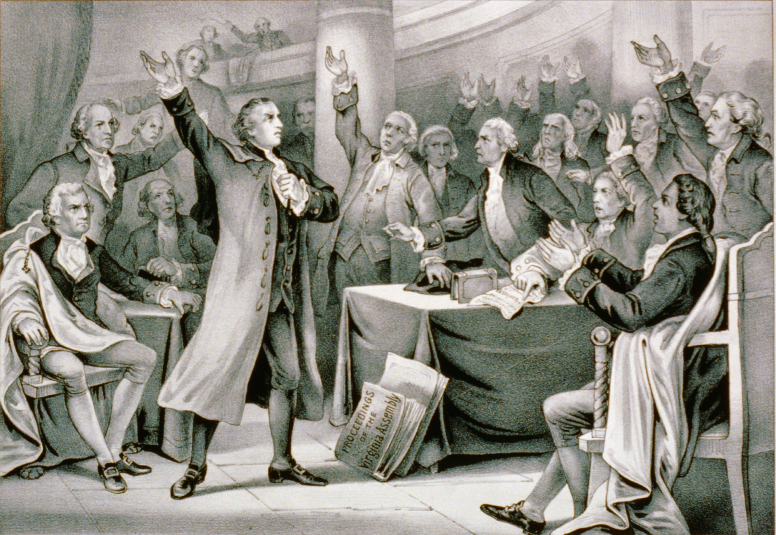
lithograph imagining Patrick Henry's Liberty or Death speech in Richmond, March 23, 1775
Source Library of Congress, Currier and Ives lithograph

lithograph imagining Patrick Henry's Liberty or Death speech in Richmond, March 23, 1775
Source Library of Congress, Currier and Ives lithograph
Patrick Henry was born on May 29, 1736 at "Studley" in Hanover County. He attended school in the area until he was 10. Later he lived in "The Retreat," clerked in a Scotch merchant's store (his neighbors called him "Pahtrick") in Newcastle, and married Sarah Shelton when he was 18 years old. He moved to "Pine Slash," then into the overseer's cottage after his house burned in 1757. After trying farming for two years, he opened up a store of his own.
Henry was not known for being a hard worker in his early days. His first biographer, William Wirt, said of his career change:1
After abandoning the idea of being a storekeeper, Henry became a lawyer while living at "Shelton Tavern", operated by his father-in-law.
Seventeen-year old Thomas Jefferson observed his attitude that Christmas in 1759, noting:
Henry did not go to Williamsburg to study law at William and Mary. He read the law books at home in Hanover Tavern. When he thought his self-study was sufficient, he went to Williamsburg to get his professional license to practice law signed by George Wythe and John Randolph, then returned immediately to Hanover County.
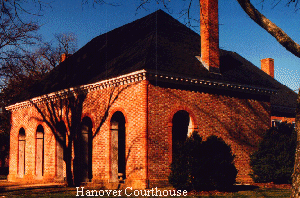
Patrick Henry gained fame in 1763 at Hanover Courthouse in a case case since known as the "Parsons' Cause"
In 1764 he moved to Roundabout Creek in Louisa County, six miles south of Hanover Courthouse. He practiced law in Spotsylvania and other counties within a horseback ride. He finally was financially established.
He won election to the House of Burgesses from Louisa County and took his seat in May, 1765. The House met in Williamsburg, where he increased his fame as a Virginia patriot with his speech and resolutions against the Stamp Act at the Capitol.
With his fame, his income as a lawyer grew. He was able to speculate in western lands, at the expense of his father-in-law. He traveled west across the Blue Ridge at Buford Gap and passed by the future site of Roanoke, explored the New River country near the homestead of his brother-in-law William Christian. Henry rode down the Wilderness Road through a community called "Wolf Hills" (later called Abingdon) and along the Holston River drainage to the "Long Island."
He stopped at Fort Robinson (renamed Fort Patrick Henry at the start of the Revolutionary War), crossed the divide into the Clinch River and looked for Henry's property on Moccasin Creek, and then returned through the New River drainage again. When he returned to Tidewater, he purchased the old Chiswell plantation house at Scotchtown in Hanover near his father-in-law at Mount Brilliant - but kept up his interest in western lands.
In 1770 Henry took his first trip outside Virginia. He went to New York City with Richard Bland as a Virginian commissioner to deal with the Native American trade. At this time the colonies' attempts to block the Townsend Duties through non-importation agreements had failed, but the governors of the colonies still blocked the gathering of representatives from different colonies. Henry did not linger, but hurried back to his home colony.
From Scotchtown, Henry later left to attend the House of Burgesses, including extra-legal meetings in the Apollo Room of the Raleigh Tavern as Virginia loyalties grew to overwhelm the ties of interest and affection to England.
The First Virginia Convention met in the Capitol during the first week of August, 1774. That convention elected the Virginia representatives to the First Continental Congress. After the election, George Washington invited Patrick Henry to travel with him to that meeting. Henry first stopped by the home of Edmund Pendleton in Caroline County. After spending the night (along with neighbor George Mason) at Washington's plantation, Henry, Pendleton, and Washington rode from Mount Vernon halfway to Annapolis the first day, crossed the Chesapeake Bay by boat on the second day, spent the third night at New Town (on the Chester River in Maryland), reached Newcastle on the Delaware River the fourth night, and finally arrived at Philadelphia after five days on horseback.
There he stayed with Richard Henry Lee, and joined the debates in Carpenter's Hall. On Tuesday, September 6, 1774 he dramatically claimed "I am not a Virginian, but an American," and spurred the first Continental Congress to resolve that the unity of the different colonies was more important than their differences.
Henry saw his brother-in-law William Christian at Scotchtown, shortly after returning from Philadelphia in October, 1774. Christian had participated in Lord Dunmore's War, defeating the Shawnee at Point Pleasant. His news was more welcome than the realization that Henry's wife, Sallie Shelton Henry, had to be confined to a room in the basement of Scotchtown because of her mental illness, apparently a deep depression after the birth of her last child. She died in February, 1776 and was buried in an unmarked grave on the plantation.
The Second Virginia Convention was held in Richmond rather than in the capital of the colony at Williamsburg, avoiding direct confrontation with Lord Dunmore and his handful of British soldiers in Williamsburg. On March 23, 1775 at the main church of the Henrico Parish, St. John's Church, Henry delivered his famous "Give Me Liberty or Give Me Death" speech. In it, he proposed the colony arm itself in preparation for war with England. Once again he stirred the average Virginian freeholder (white males with enough land to qualify to vote), while stepping out in front of the gentry's willingness to confront the legal government of the colony.
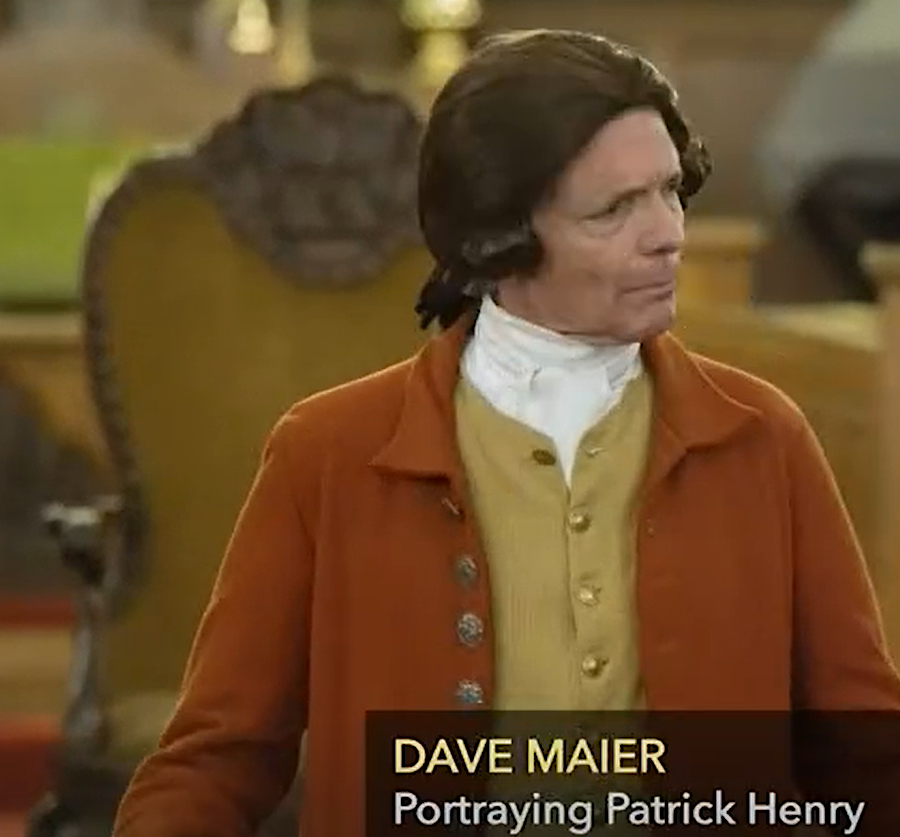
actors recreate Patrick Henry's Liberty or Death speech at St. John's Church in Richmond
Source CNN, Lesson Plan: The Second Virginia Convention (1775) (Clip 7)
During the night of April 20-21, 1775, the royal governor (Lord Dunmore) secretly seized the colony's official stockpile of gunpowder from the Magazine in Williamsburg. The political leaders in Virginia, including the Speaker of the House of Burgesses and the mayor of Williamsburg, calmed the outraged residents of the local area on April 21 before open warfare broke out. Virginia had not yet heard about the actual fighting at Lexington and Concord on April 19.
Hot-headed Patrick Henry alarmed the cool-headed Virginia gentry by leading the Hanover militia towards Williamsburg on May 3. Henry halted at Duncastle's Ordinary a dozen miles from Williamsburg, where he negotiated a peaceful payment for the powder rather than a military assault on the Governor and the few British military forces at his disposal.
After settling for payment of the gunpowder, Henry then traveled to the Second Continental Congress in what's now Independence Hall, the former Pennsylvania State House at the modern Independence National Historical Park in Philadelphia. He was escorted the whole way by armed volunteers, in case the British authorities tried to seize him as an outlaw. This was his third and last trip outside Virginia's boundaries.
At that Congress Henry was active in dealing with the titles to western lands, including the Vandalia Company claims to Kentucky country.
Henry left the Second Continental Congress when it was near its end He reached Richmond to join the Third Virginia Convention in August, 1775. There he learned he had been chosen head of the First Virginia Regiment (over Hugh Mercer and the younger Thomas Nelson), when the militia was reorganized. He accepted the office before the Committee of Safety in Hanover Town on September 18, 1775.
However, this choice was not universally popular. In addition to concern that he had no military experience, Henry's aggressive courtship of the small farmers and his rebelliousness against England had created fears in the gentry that he might become a Dictator. His First Regiment was not sent to counter Lord Dunmore in the Norfolk/Great Bridge area, despite the Emancipation Proclamation, and the rivalry with William Woodford of the Second Regiment grew intense. Henry was kept near Williamsburg instead, though soldiers on the frontier near Wheeling honored him by renaming Fort Fincastle after him. He finally resigned when the regiment was accepted into the Continental Army, but he was not given authority over all Virginia forces and resigned in February, 1776.
Henry was elected (from Hanover County) to serve in the Fifth Virginia Convention during May/June, 1776. That convention was in Williamsburg, since Governor Dunmore had fled the state. That last convention (the first official General Assembly met in October, 1776...) voted for independence from England , approved the Virginia Declaration of Rights, and adopted the first Virginia Constitution.
Henry was the first elected governor of Virginia in 1776, serving three one-years terms as defined in the first (1776) constitution of the new Commonwealth of Virginia. He moved from Scotchtown to the Governor's Palace in Williamsburg. The palace had been used as a hospital after Dunmore abandoned it, but was converted back to a residence for Henry.
As the newly-elected governor, Henry supported George Rogers Clark when he requested gunpowder to fight the British and the native Americans on the "Northwest" frontier (north of the Ohio River). He supported Clark again two years later in 1778, when through secret orders the Virginia government authorized an attack on British forts that ultimately led to the addition of the Northwest to the new United States in Article 2 of the Treaty of Paris in 1783.
Henry's wide Sarah had died at Scotchtown in 1775, while suffering mental illness (perhaps post-partum depression after the birth of their last child, Edward, in 1771). On his later travels as governor between Williamsburg and Scotchtown, Henry "called at" the plantation of Nathaniel Dandridge and courted one of his young daughters, a granddaughter of Governor Spotswood. He married Dorothea ("Dolly") in 1777 and considered retiring to the area near his brother-in-law, William Christian, but they lived primarily in the Governor's Palace built by Governor Spotswood in Williamsburg in the early 1700's.
Henry was more rival than partner of Thomas Jefferson. Jefferson wrote Henry in 1779 when it appeared the British soldiers captured in 1777 at the Battle of Saratoga would be moved from Charlottesville.
At the end of his third term in May, 1779, the British (led by Commodore Sir George Collier and Major General Edward Mathew) sailed into the James River and destroyed the "rebel" shipyard at Gosport (Norfolk), as well as supplies and tobacco at Suffolk. That led the Virginians to move the capital to Richmond, further inland. When Henry was governor again for two more years, in 1784-86, he lived in the new state capital - Richmond.
After turning over the responsibilities as governor to Thomas Jefferson in 1779, Henry moved west to "Leatherwood" in Henry County, which had been created out of Pittsylvania County in 1776. By selling Scotchtown and some western lands (in Botetourt County and Kentucky), he had bought himself a fresh start on the frontier again. This time, he was no longer a failed storekeeper or a newly-famous young lawyer. Henry held on to his Bedford County land, hoping to find gold.
Cornwallis came near Leatherwood during his chase of the Continentals under Nathaniel Greene through the Carolinas. Greene retreated across the Dan River, then moved south again and defeated Cornwallis at Guilford Court House - 40 miles from Patrick Henry's new home.
Henry came closer to the war when he attended the General Assembly in May, 1781. He went to Charlottesville rather than Richmond to attend the session, since it had been moved inland to avoid the marauding English. Banastre Tarleton's raid on Charlottesville chased the legislature further west to Staunton. Reportedly on the flight four famous Virginia leaders had requested supper at a rural cabin. The woman of the cabin had rejected three requests for assistance, until she heard Patrick Henry was in the party - at which she decided it was appropriate to assist the travelers, rather than reject them as cowards.
Henry was at Leatherwood when Cornwallis was cornered at Yorktown and surrendered on October 19, 1783.
James Madison managed to overcome Governor Henry's proposal in 1784 for a "general assessment" to tax all freeholders to support churches and schools, and pass instead Thomas Jefferson's Statute for Religious Freedom. Madison helped get Henry elected governor, because that kept Henry from speaking so eloquently during debates in the General Assembly.
Patrick Henry moved to Richmond after being elected governor again. Productivity at Leatherwood dropped to where it produced only 12 hogsheads of tobacco in 1786. The Governor's Mansion was too small for his large family, so he rented a home in Chesterfield County known as "Salisbury" while governor.
Henry was eligible to serve a sixth term as governor, but declined. In his last year, 1786, he helped prevent the Congress (the one based on the Articles of Confederation) from negotiating away to Spain the American right for free traffic on the Mississippi River. This transportation corridor was essential for settlers in the Kentucky counties - it was too expensive to ship crops across the mountains to Petersburg or Richmond.
Henry left his position as governor on November 30, 1786, and then disappeared for several months. The next governor, Edmund Randolph, sent a letter to his old plantation at Leatherwood to encourage Henry to accept his election as a Virginia delegate to what became the Constitutional Convention, which met in 1787 in Philadelphia. Henry declined, but the response showed that he had a new home near the Appomattox River in Prince Edward County, to be known later as "Pleasant Grove" (and also as "Cliffside" or "East Cliff.").
He was elected from there to serve in the General Assembly in 1787 (making it the fourth county he represented, after Louisa, Hanover, and Henry) and the1788 convention considering ratification of the proposed Constitution.
At the ratification convention in Richmond in June, 1788, Henry stayed at the Swan hotel on Broad Street behind the Capitol. He lost, just barely, as the delegates from the Kentucky counties ended up voting for ratification without requiring that a Bill of Rights be added first.
Patrick Henry was more self-taught than a successful student in school, but he supported Hampden-Sydney College in particular. He served on the board in 1789-92, travelling to the courthouse at Prince Edward County for meetings at least 6 times. In this same time he traveled to different courthouses to serve as a lawyer, since he needed the fees to both pay debts and continue speculating in land. He even traveled to Leesburg in 1789 to defend Robert "Councillor" Carter from a lawsuit filed by his relative, Charles Carter of Shirley Plantation. Later, in 1791 (and in the 1793 appeal), he argued parts of the British Debts case in Federal court in Richmond.
Henry moved his large family again, in 1792 to "Long Island" in Campbell County, which he apparently purchased from Governor "Light Horse Harry" Lee. From there he shipped tobacco down the James River, after hauling by wagon to Lynchburg.
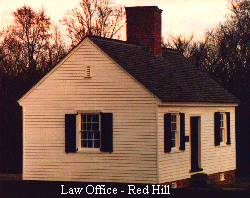
That same year he began to purchase lands along the Staunton River at "Red Hill" in Charlotte County. It was closer to the social swirl in Lynchburg, and he moved there with his large family in 1794. His library of over 200 books included 8 texts on geography.
Patrick Henry did not retire from being a lawyer, despite his age. His celebrated defense of Richard Randolph was in 1793 in Cumberland County. He used the extremely high fee that he earned to purchase a 4-wheeled carriage, for more-convenient travel on the rough roads of the day.
During George Washington's second term as President, Henry declined opportunities to serve as Chief Justice of the Supreme Court, Secretary of State, and Ambassador to France. He declined to run for President in 1796, but he still got a few electoral votes.
Dorothea gave birth to the couple's last child in January, 1798. That daughter, Jane, was their 11th child (he had six with his first wife). She lived only 4 days.
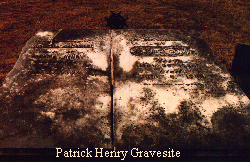
In 1799, Henry was elected to serve in the General Assembly from Charlotte County (the fifth he represented as an elected official). He made his last speech to the electorate at the courthouse (in Marysville, now Charlotte Court House) on March 4, 1799 but died on June 6 before traveling to Richmond. He was buried at Red Hill, and his second wife Dolly was buried there too in 1831.
Source: Preservation Virginia, Going to the Source: How Historic Documents Reveal Life at Patrick Henry's Scotchtown and Red Hill
Source: Special 245th Anniversary Reenactment of Patrick Henry's "Liberty or Death" Speech